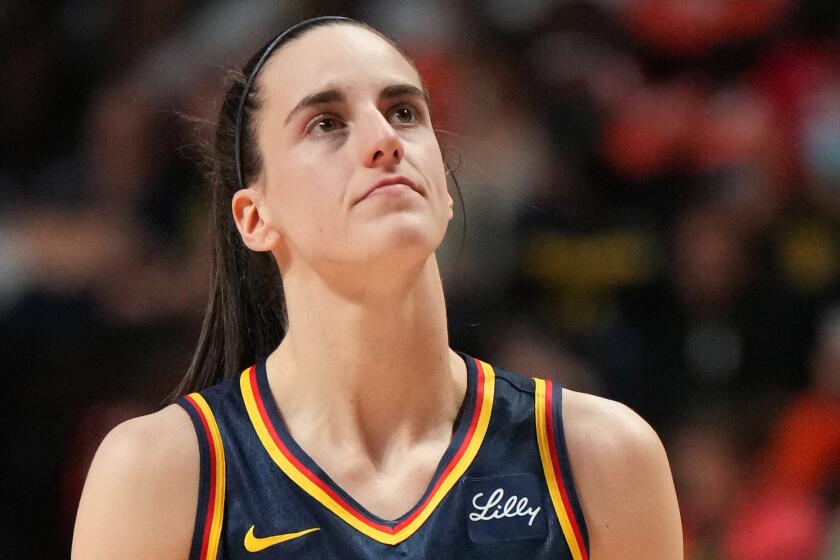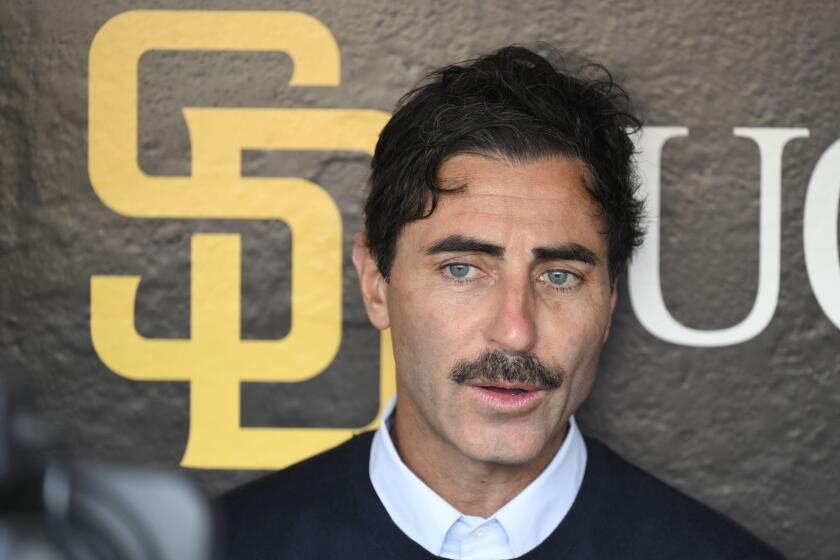Dodgers commit to expensive improvements, but not the stadium
The new scoreboards are nice, and so is the new sound system. The expensive players are nice too.
But, for all the improvements to the Dodgers and their ballpark, there are five words the new owners absolutely refuse to say: “We’re staying at Dodger Stadium.”
Say what you will about Frank McCourt, but the man publicly committed the team to the stadium for another 50 years. He ran out of money, and Bud Selig ran him out of baseball, but at least he had the right idea.
GRAPHIC: New look for old ballpark
The Dodgers’ new owners have the money, so much so that they can throw $100 million into Dodger Stadium renovations without making any long-term commitment to stay there.
“Right now, we are here,” Dodgers President Stan Kasten said Tuesday. “I don’t know if that’s for 10 years, 50 years or 100 years.”
Kasten spoke after a news conference in which the Dodgers unveiled this winter’s round of stadium upgrades. There are new scoreboards, sound system and clubhouse; reliable cell and wi-fi service; expanded and modernized restrooms — no more troughs! — and family play areas featuring life-size bobbleheads and oversize replicas of the Dodgers’ six World Series championship rings.
The Dodgers also will expand concourses by removing the last two to four rows of seats on each level. Under a city permit, the Dodgers are limited to 56,000 seats, although that capacity was exceeded when McCourt installed baseline box seats.
The renovations are limited not by what the new owners can afford but by what construction crews can accomplish in one winter.
“We also left out about another 100 things,” Kasten said.
What those things might be next winter, and in winters to come, falls to Janet Marie Smith, baseball’s foremost ballpark architect and perhaps Kasten’s most inspired addition to the Dodgers’ front office.
Smith’s distinctive and imaginative design of Baltimore’s Camden Yards led baseball out of multipurpose stadiums and into signature ballparks. When the Boston Red Sox were sold in 2002, the new owners hired Smith to figure out how to preserve and enhance Fenway Park.
That was a revelation in itself. The creaky old park, wedged within a city block, was ripe for replacement. As you might recall, McCourt owned a few parking lots in Boston, and on them he envisioned a new waterfront ballpark for the Red Sox.
Fenway might not have lived to see its second century had the new owners — John Henry, Tom Werner and Larry Lucchino — not directed Smith to determine whether the structure could survive for the long term. Once Smith said yes, the new owners committed to Fenway, with a reported $300 million in renovations over 10 years.
The Dodgers’ new owners, Smith said Tuesday, have not asked her a thing about Dodger Stadium as a long-term home.
“This assignment is very different,” she said. “We’ll play baseball in April and see what we do after that.
“Whether the Dodgers are here for five years or 50 years does not affect the assignment they have given to me. The commitment to longevity is not a criterion of this investment.”
That the Dodgers’ new owners — Mark Walter, Todd Boehly, Magic Johnson, Peter Guber and Bobby Patton — can pour nine figures into stadium renovations without a long-term commitment to the stadium is impressive. That lack of commitment is understandable too, given the potential for development of the Dodger Stadium parking lot and the uncertainty surrounding a possible downtown ballpark site, the sale of AEG and the NFL’s reluctance to commit to Farmers Field.
Walter and Co. might not have asked Smith about the long-term viability of Dodger Stadium, but we did. If Fenway can survive 100 years in the harsh New England winters, she said, Dodger Stadium is more than fine after 50 years in Southern California.
“Structurally, it’s not going anywhere,” Smith said.
She also said the Dodgers have enough space to accommodate whatever modern money-makers the owners might want to add — for example, the shops, restaurants and team museum McCourt had proposed beyond center field.
The rest is up to the owners. We’d love to hear them say those five words — and we don’t mean, “It’s time for Dodger baseball.”
Twitter: @BillShaikin
More to Read
Go beyond the scoreboard
Get the latest on L.A.'s teams in the daily Sports Report newsletter.
You may occasionally receive promotional content from the Los Angeles Times.











